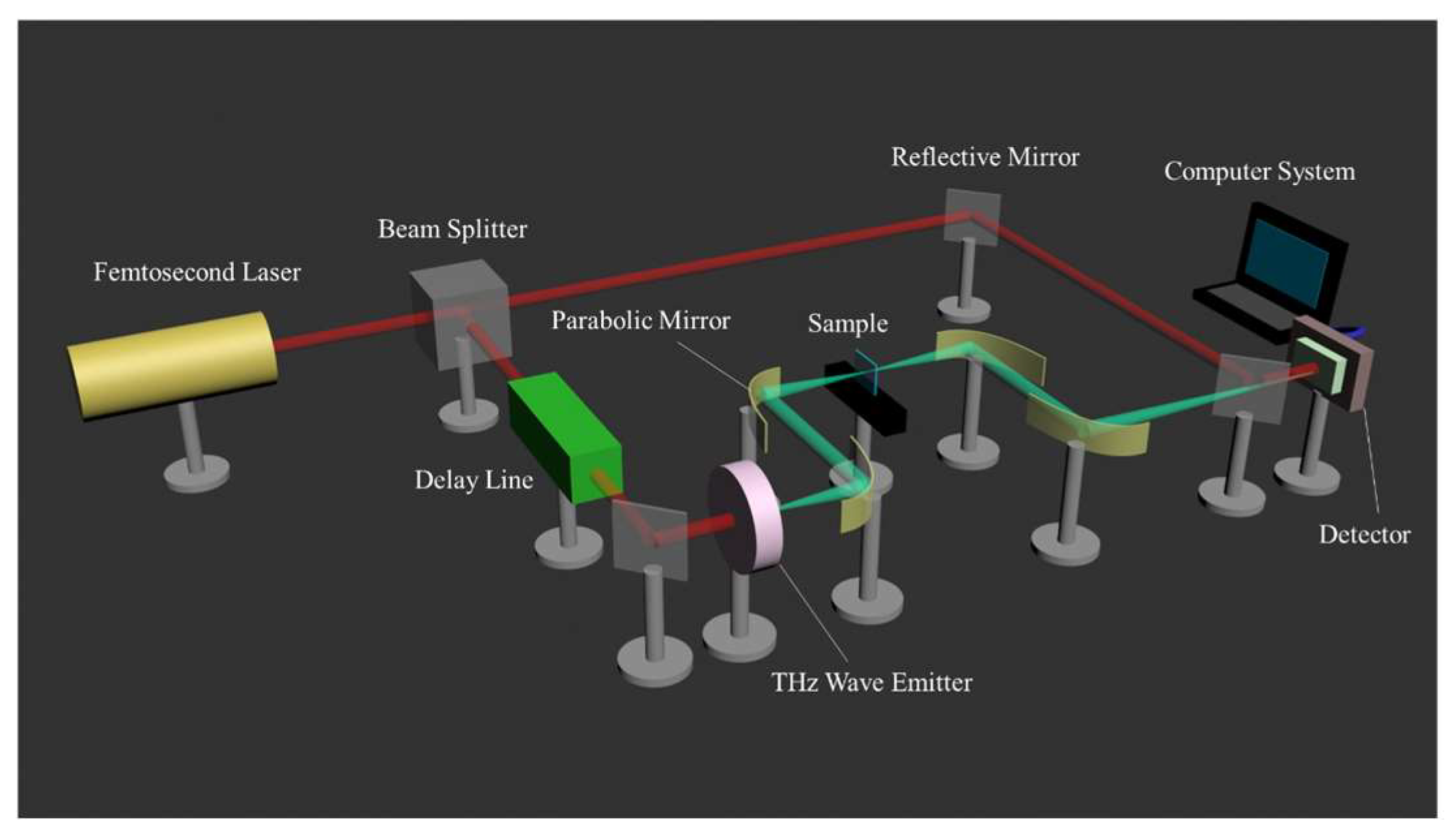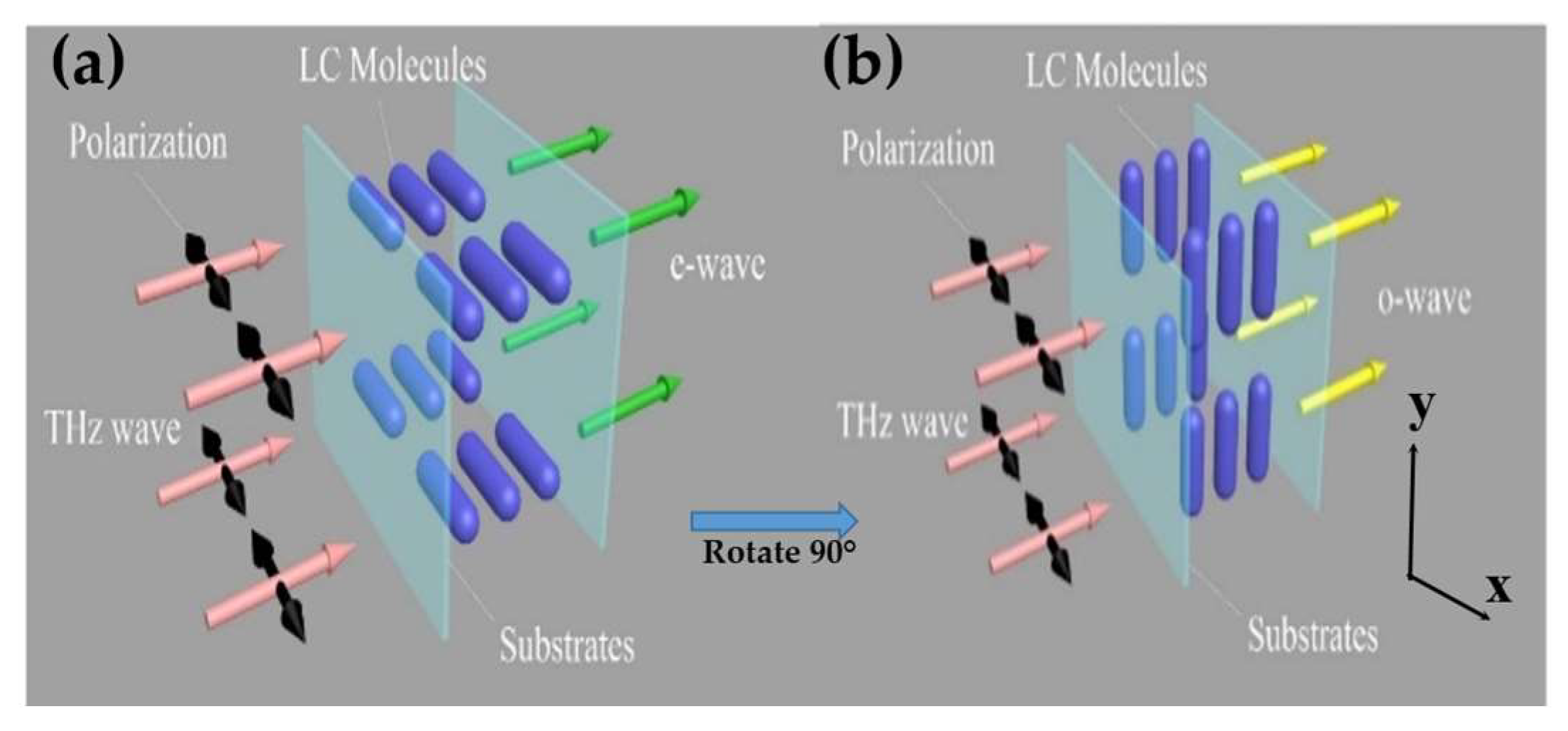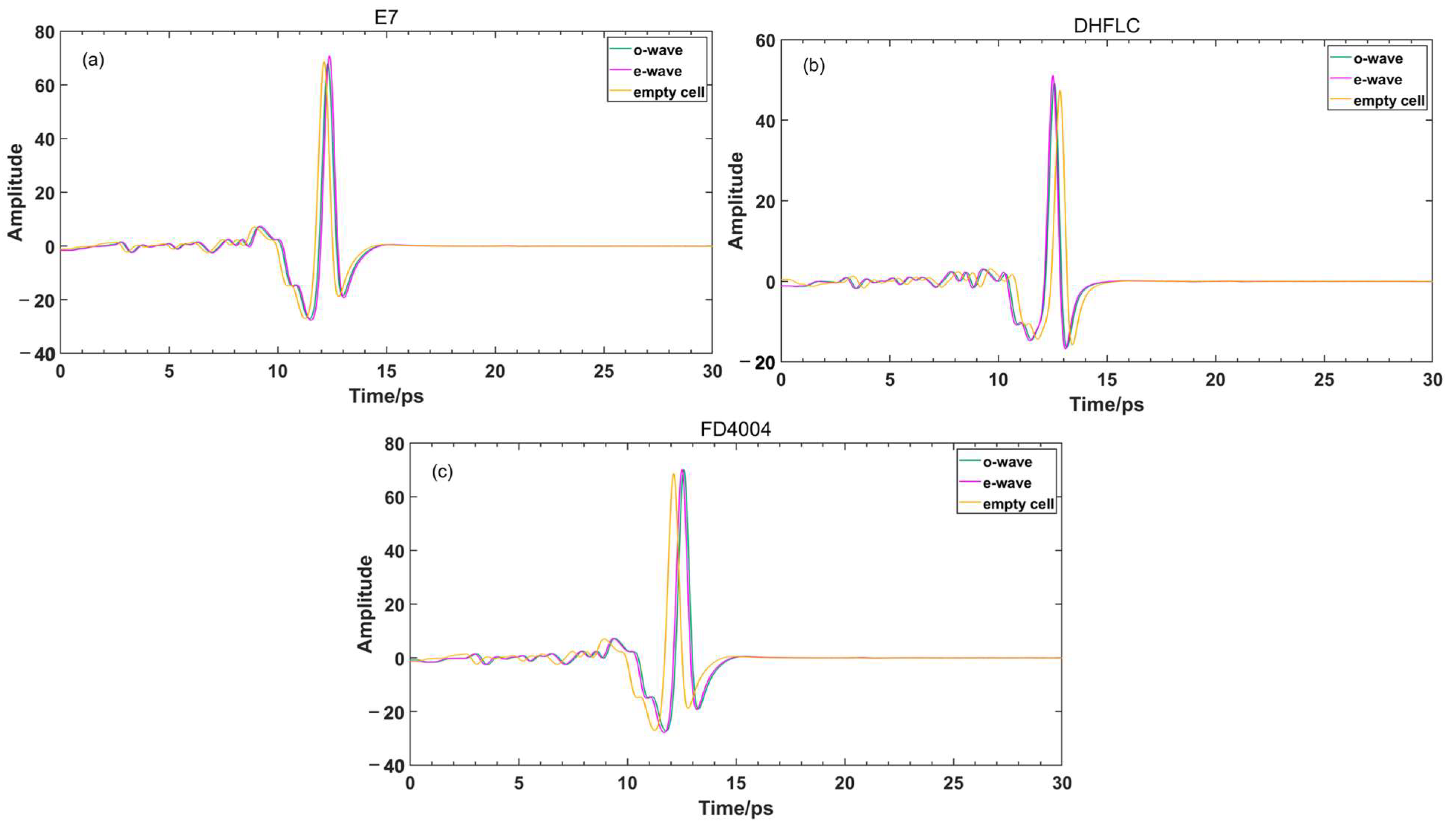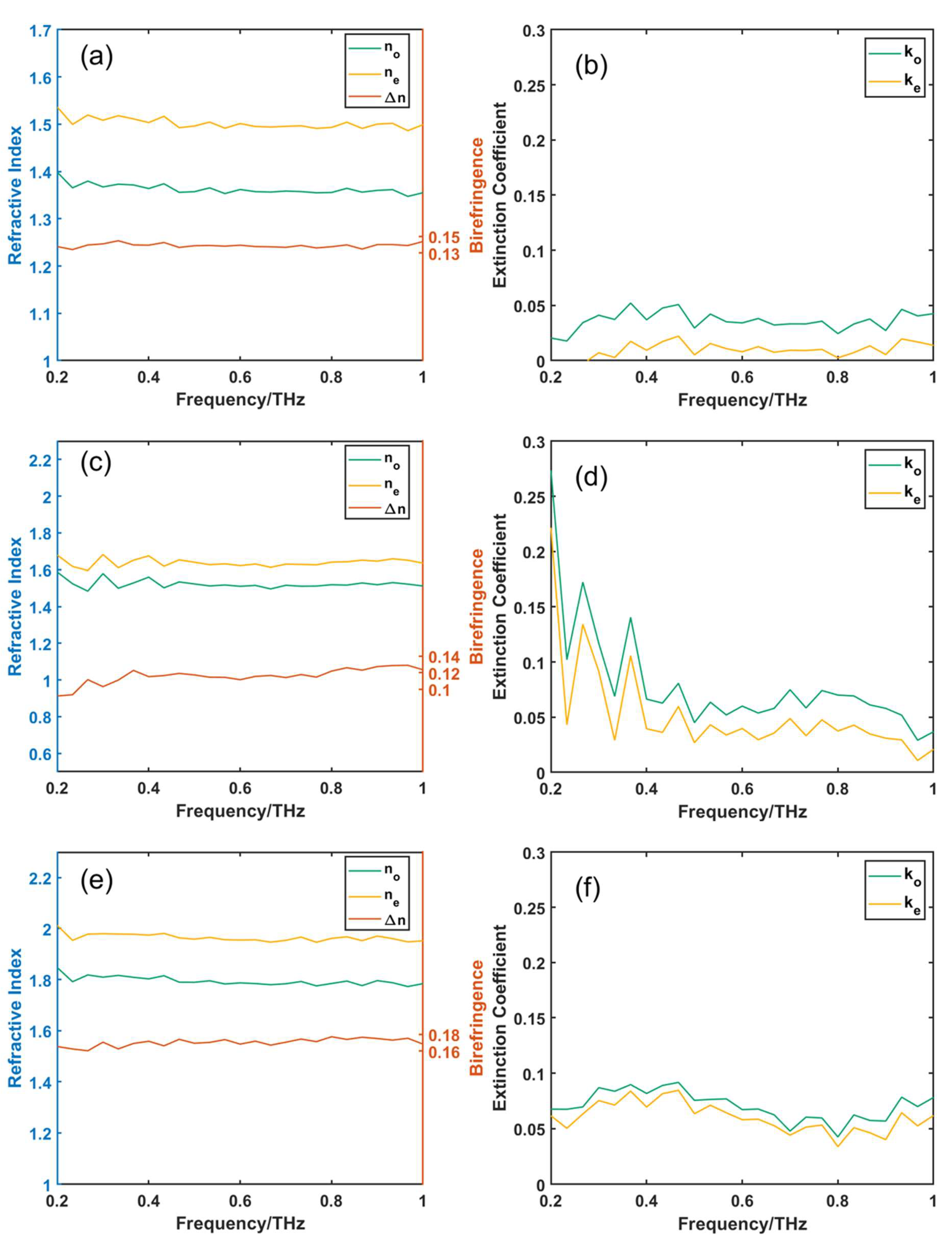The Birefringence and Extinction Coefficient of Ferroelectric Liquid Crystals in the Terahertz Range
Abstract
:1. Introduction
2. Experiment
3. Results and Discussion
4. Conclusions
Author Contributions
Funding
Institutional Review Board Statement
Informed Consent Statement
Data Availability Statement
Conflicts of Interest
References
- Pawar, A.Y.; Sonawane, D.D.; Erande, K.B.; Derle, D.V. Terahertz technology and its applications. Drug Invent. Today 2013, 5, 157–163. [Google Scholar] [CrossRef]
- Guerboukha, H.; Nallappan, K.; Skorobogatiy, M. Toward real-time terahertz imaging. Adv. Opt. Photonics 2018, 10, 843–938. [Google Scholar] [CrossRef]
- Chan, W.L.; Deibel, J.; Mittleman, D.M. Imaging with terahertz radiation. Rep. Prog. Phys. 2007, 70, 1325–1379. [Google Scholar] [CrossRef]
- Stantchey, R.L.; Yu, X.; Blu, T.; Pickwell-MacPherson, E. Real-time terahertz imaging with a single-pixel detector. Nat. Commun. 2020, 11, 8. [Google Scholar] [CrossRef]
- Bennett, D.B.; Taylor, Z.D.; Tewari, P.; Singh, R.S.; Culjat, M.O.; Grundfest, W.S.; Sassoon, D.J.; Johnson, R.D.; Hubschman, J.P.; Brown, E.R. Terahertz sensing in corneal tissues. J. Biomed. Opt. 2011, 16, 8. [Google Scholar] [CrossRef]
- Beruete, M.; Jauregui-Lopez, I. Terahertz Sensing Based on Metasurfaces. Adv. Opt. Mater. 2020, 8, 26. [Google Scholar] [CrossRef]
- Singh, R.; Cao, W.; Al-Naib, I.; Cong, L.Q.; Withayachumnankul, W.; Zhang, W.L. Ultrasensitive terahertz sensing with high-Q Fano resonances in metasurfaces. Appl. Phys. Lett. 2014, 105, 5. [Google Scholar] [CrossRef]
- Cao, P.F.; Li, C.C.; Li, Y.; Wu, Y.Y.; Chen, X.Y.; Wu, T.; Zhang, X.Q.; Yuan, M.R.; Wang, Z.L. Electromagnetically Induced Transparency-Like Approach Based on Terahertz Metamaterials for Ultrasensitive Refractive Index Sensors. IEEE Sens. J. 2022, 22, 2110–2118. [Google Scholar] [CrossRef]
- Huang, K.-C.; Wang, Z. Terahertz terabit wireless communication. IEEE Microw. Mag. 2011, 12, 108–116. [Google Scholar] [CrossRef]
- Krumbholz, N.; Gerlach, K.; Rutz, F.; Koch, M.; Piesiewicz, R.; Kürner, T.; Mittleman, D. Omnidirectional terahertz mirrors: A key element for future terahertz communication systems. Appl. Phys. Lett. 2006, 88, 202905. [Google Scholar] [CrossRef]
- Mumtaz, S.; Jornet, J.M.; Aulin, J.; Gerstacker, W.H.; Dong, X.; Ai, B. Terahertz communication for vehicular networks. IEEE Trans. Veh. Technol. 2017, 66, 5617–5625. [Google Scholar]
- Fan, F.; Zhao, H.J.; Ji, Y.Y.; Jiang, S.L.; Tan, Z.Y.; Cheng, J.R.; Chang, S.J. Spin-Decoupled Beam Steering with Active Optical Chirality Based on Terahertz Liquid Crystal Chiral Metadevice. Adv. Mater. Interfaces 2023, 9, 2202103. [Google Scholar] [CrossRef]
- Song, H.-J.; Lee, N. Terahertz Communications: Challenges in the Next Decade. IEEE Trans. Terahertz Sci. Technol. 2022, 12, 105–117. [Google Scholar] [CrossRef]
- Zaytsev, K.; Dolganova, I.; Chernomyrdin, N.; Katyba, G.; Gavdush, A.; Cherkasova, O.; Komandin, G.; Shchedrina, M.; Khodan, A.; Ponomarev, D. The progress and perspectives of terahertz technology for diagnosis of neoplasms: A review. J. Opt. 2019, 22, 013001. [Google Scholar] [CrossRef]
- Brun, M.-A.; Formanek, F.; Yasuda, A.; Sekine, M.; Ando, N.; Eishii, Y. Terahertz imaging applied to cancer diagnosis. Phys. Med. Biol. 2010, 55, 4615. [Google Scholar] [CrossRef]
- Parrott, E.P.J.; Sun, Y.; Pickwell-MacPherson, E. Terahertz spectroscopy: Its future role in medical diagnoses. J. Mol. Struct. 2011, 1006, 66–76. [Google Scholar] [CrossRef]
- Reid, C. Spectroscopic Methods for Medical Diagnosis at Terahertz Wavelengths; UCL (University College London): London, UK, 2009. [Google Scholar]
- Hermans, R.I.; Seddon, J.; Shams, H.; Ponnampalam, L.; Seeds, A.J.; Aeppli, G. Ultra-high-resolution software-defined photonic terahertz spectroscopy. Optica 2020, 7, 1445–1455. [Google Scholar] [CrossRef]
- Sengupta, K.; Nagatsuma, T.; Mittleman, D.M. Terahertz integrated electronic and hybrid electronic–photonic systems. Nat. Electron. 2018, 1, 622–635. [Google Scholar] [CrossRef]
- Shin, D.C.; Kim, B.S.; Jang, H.; Kim, Y.J.; Kim, S.W. Photonic comb-rooted synthesis of ultra-stable terahertz frequencies. Nat. Commun. 2023, 14, 10. [Google Scholar] [CrossRef]
- Xu, S.T.; Fan, F.; Cao, H.Z.; Wang, Y.H.; Chang, S.J. Liquid crystal integrated metamaterial for multi-band terahertz linear polarization conversion. Chin. Opt. Lett. 2021, 19, 6. [Google Scholar] [CrossRef]
- Degl’Innocenti, R.; Jessop, D.S.; Shah, Y.D.; Sibik, J.; Zeitler, J.A.; Kidambi, P.R.; Hofmann, S.; Beere, H.E.; Ritchie, D.A. Terahertz optical modulator based on metamaterial split-ring resonators and graphene. Opt. Eng. 2014, 53, 057108. [Google Scholar] [CrossRef]
- Liang, G.; Hu, X.; Yu, X.; Shen, Y.; Li, L.H.; Davies, A.G.; Linfield, E.H.; Liang, H.K.; Zhang, Y.; Yu, S.F. Integrated terahertz graphene modulator with 100% modulation depth. ACS Photonics 2015, 2, 1559–1566. [Google Scholar] [CrossRef]
- Yu, H.G.; Wang, H.C.; Shen, Z.X.; Tao, S.N.; Ge, S.J.; Hu, W. Photo-reconfigurable and electrically switchable spatial terahertz wave modulator Invited. Chin. Opt. Lett. 2023, 21, 5. [Google Scholar] [CrossRef]
- Collings, P.J.; Patel, J.S. Handbook of Liquid Crystal Research; Swarthmore College: Swarthmore, PA, USA, 1997. [Google Scholar]
- Zheng, Z.; Hu, H.; Zhang, Z.; Liu, B.; Li, M.; Qu, D.-H.; Tian, H.; Zhu, W.-H.; Feringa, B.L. Digital photoprogramming of liquid-crystal superstructures featuring intrinsic chiral photoswitches. Nat. Photonics 2022, 16, 226–234. [Google Scholar] [CrossRef]
- Liu, J.; Song, Z.P.; Sun, L.Y.; Li, B.X.; Lu, Y.Q.; Li, Q. Circularly polarized luminescence in chiral orientationally ordered soft matter systems. Responsive Mater. 2023, 1, e20230005. [Google Scholar] [CrossRef]
- Wu, S.-T. Birefringence dispersions of liquid crystals. Phys. Rev. A 1986, 33, 1270. [Google Scholar] [CrossRef]
- Ji, Y.-Y.; Fan, F.; Wang, X.-H.; Chang, S.-J. Broadband controllable terahertz quarter-wave plate based on graphene gratings with liquid crystals. Opt. Express 2018, 26, 12852–12862. [Google Scholar] [CrossRef]
- Hsieh, C.-F.; Yang, C.-S.; Shih, F.-C.; Pan, R.-P.; Pan, C.-L. Liquid-crystal-based magnetically tunable terahertz achromatic quarter-wave plate. Opt. Express 2019, 27, 9933–9940. [Google Scholar] [CrossRef]
- Yang, J.; Xu, L.; Zhang, G.Z.; Li, X.P.; Li, Y.; Hu, M.G.; Li, J.; Lu, H.B.; Deng, G.S.; Yin, Z.P. Rapid terahertz wave manipulation in a liquid-crystal-integrated metasurface structure. Opt. Express 2022, 30, 33014–33021. [Google Scholar] [CrossRef] [PubMed]
- Sahoo, A.K.; Lin, Y.H.; Yang, C.S.; Wada, O.; Yen, C.L.; Pan, C.L. Electrically tunable dual-layer twisted nematic liquid crystal THz phase shifters with intermediate composite polymer thin film. Opt. Mater. Express 2022, 12, 4733–4754. [Google Scholar] [CrossRef]
- Wang, L.; Lin, X.-W.; Hu, W.; Shao, G.-H.; Chen, P.; Liang, L.-J.; Jin, B.-B.; Wu, P.-H.; Qian, H.; Lu, Y.-N.; et al. Broadband tunable liquid crystal terahertz waveplates driven with porous graphene electrodes. Light Sci. Appl. 2015, 4, e253. [Google Scholar] [CrossRef]
- Wang, J.; Tian, H.; Wang, Y.; Li, X.; Cao, Y.; Li, L.; Liu, J.; Zhou, Z. Liquid crystal terahertz modulator with plasmon-induced transparency metamaterial. Opt. Express 2018, 26, 5769–5776. [Google Scholar] [CrossRef] [PubMed]
- Lin, S.; Tang, Y.; Kang, W.; Bisoyi, H.K.; Guo, J.; Li, Q. Photo-triggered full-color circularly polarized luminescence based on photonic capsules for multilevel information encryption. Nat. Commun. 2023, 14, 3005. [Google Scholar] [CrossRef] [PubMed]
- Liu, J.; Song, Z.P.; Wei, J.; Wu, J.J.; Wang, M.Z.; Li, J.G.; Ma, Y.; Li, B.X.; Lu, Y.Q.; Zhao, Q. Circularly Polarized Organic Ultralong Room-Temperature Phosphorescence with A High Dissymmetry Factor in Chiral Helical Superstructures. Adv. Mater. 2023, 2306834. [Google Scholar] [CrossRef] [PubMed]
- Cho, S.; Yoshida, H.; Ozaki, M. Tunable polarization volume gratings based on blue phase liquid crystals. Opt. Express 2022, 30, 1607–1614. [Google Scholar] [CrossRef] [PubMed]
- Li, Y.; Yin, Z.; Luo, D. Fabrication and application of free-standing fiber based on blue phase liquid crystal. Opt. Lett. 2023, 48, 89–92. [Google Scholar] [CrossRef]
- Li, Y.; Zhan, T.; Wu, S.-T. Flat cholesteric liquid crystal polymeric lens with low f-number. Opt. Express 2020, 28, 5875–5882. [Google Scholar] [CrossRef]
- Zeng, T.; Xie, J.; Zhou, Y.; Fan, F.; Wen, S. Selectively reflective edge detection system based on cholesteric liquid crystal. Opt. Lett. 2023, 48, 795–798. [Google Scholar] [CrossRef]
- Mukherjee, S.; Yuan, Z.-N.; Sun, Z.-B.; Li, A.-R.; Kang, C.-B.; Kwok, H.-S.; Srivastava, A.K. Fast refocusing lens based on ferroelectric liquid crystals. Opt. Express 2021, 29, 8258–8267. [Google Scholar] [CrossRef]
- Sun, Z.-B.; Yuan, Z.-N.; Nikita, A.; Kwok, H.-S.; Srivastava, A.K. Fast-switchable, high diffraction-efficiency ferroelectric liquid crystal Fibonacci grating. Opt. Express 2021, 29, 13978–13986. [Google Scholar] [CrossRef]
- Liu, Q.F.; Luo, D.; Li, S.X.; Tian, Z. The birefringence and extinction coefficient of positive and negative liquid crystals in the terahertz range. Liq. Cryst. 2016, 43, 796–802. [Google Scholar] [CrossRef]
- Liu, Q.; Luo, D.; Zhang, X.; Li, S.; Tian, Z. Refractive index and absorption coefficient of blue phase liquid crystal in terahertz band. Liq. Cryst. 2017, 44, 348–354. [Google Scholar] [CrossRef]
- Pozhidaev, E.P.; Kiselev, A.D.; Srivastava, A.K.; Chigrinov, V.G.; Kwok, H.-S.; Minchenko, M.V. Orientational Kerr effect and phase modulation of light in deformed-helix ferroelectric liquid crystals with subwavelength pitch. Phys. Rev. E 2013, 87, 052502. [Google Scholar] [CrossRef] [PubMed]





Disclaimer/Publisher’s Note: The statements, opinions and data contained in all publications are solely those of the individual author(s) and contributor(s) and not of MDPI and/or the editor(s). MDPI and/or the editor(s) disclaim responsibility for any injury to people or property resulting from any ideas, methods, instructions or products referred to in the content. |
© 2023 by the authors. Licensee MDPI, Basel, Switzerland. This article is an open access article distributed under the terms and conditions of the Creative Commons Attribution (CC BY) license (https://creativecommons.org/licenses/by/4.0/).
Share and Cite
Ma, Y.; Shan, Y.; Cheng, Y.; Yang, R.; Kwok, H.-S.; Zhao, J. The Birefringence and Extinction Coefficient of Ferroelectric Liquid Crystals in the Terahertz Range. Photonics 2023, 10, 1368. https://doi.org/10.3390/photonics10121368
Ma Y, Shan Y, Cheng Y, Yang R, Kwok H-S, Zhao J. The Birefringence and Extinction Coefficient of Ferroelectric Liquid Crystals in the Terahertz Range. Photonics. 2023; 10(12):1368. https://doi.org/10.3390/photonics10121368
Chicago/Turabian StyleMa, Ying, Yuhang Shan, Yongning Cheng, Ruisheng Yang, Hoi-Sing Kwok, and Jianlin Zhao. 2023. "The Birefringence and Extinction Coefficient of Ferroelectric Liquid Crystals in the Terahertz Range" Photonics 10, no. 12: 1368. https://doi.org/10.3390/photonics10121368
APA StyleMa, Y., Shan, Y., Cheng, Y., Yang, R., Kwok, H.-S., & Zhao, J. (2023). The Birefringence and Extinction Coefficient of Ferroelectric Liquid Crystals in the Terahertz Range. Photonics, 10(12), 1368. https://doi.org/10.3390/photonics10121368





